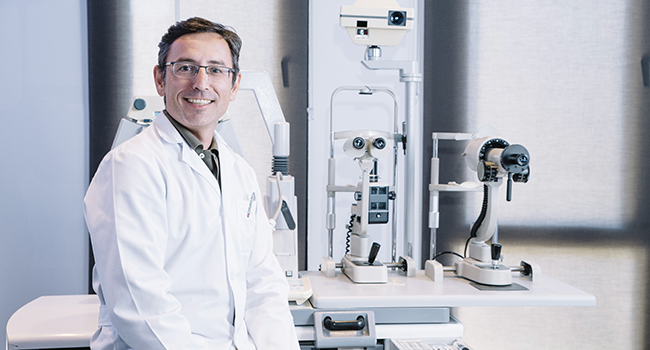How an Eye Doctor Can Transform Your Vision Health in Chino
How an Eye Doctor Can Transform Your Vision Health in Chino
Blog Article
Discovering the Most Current Technical Advancements in Optometry and What They Mean for Eye Doctors
In the ever-evolving area of optometry, current technical improvements are reshaping just how professionals approach eye care. From the precision of Optical Comprehensibility Tomography to the nuanced insights supplied by AI-driven diagnostic tools, these innovations are setting brand-new criteria in patient assessment and treatment. Teleoptometry is poised to redefine access, ensuring that knowledge transcends geographical limitations. As these improvements penetrate the practice, optometrists are confronted with the difficulty of embracing these devices to enhance person outcomes. Yet, the concern stays: how will these technical shifts redefine the functions and duties within the career?
Innovations in Diagnostic Equipment
Progressing the field of optometry, technologies in analysis devices have reinvented the method eye treatment specialists examine and identify visual problems and eye conditions. The previous years has seen considerable technological developments, enabling more comprehensive and accurate examinations. Optical Coherence Tomography (OCT), for instance, provides high-resolution cross-sectional photos of the retina, permitting the very early detection of conditions such as glaucoma and age-related macular deterioration. This non-invasive imaging method has actually become indispensable in contemporary optometric technique.
Another secret development is the intro of sophisticated corneal topography systems, which map the surface curvature of the cornea with accuracy. These devices are particularly helpful for fitting get in touch with lenses and detecting corneal disorders. Furthermore, electronic retinal imaging has actually transformed typical ophthalmoscopy, offering detailed, panoramic sights of the retina that assist in comprehensive visual exams.
The development of wavefront aberrometry has also been critical, allowing the evaluation of refractive mistakes with unrivaled accuracy (Optometrist Chino). This innovation aids in personalizing rehabilitative lenses and improving surgical results for refractive surgeries. Collectively, these analysis developments equip eye doctors to provide premium individual treatment, making certain very early treatment and tailored therapy techniques, ultimately enhancing aesthetic wellness results
AI in Individual Monitoring
Structure on the foundation of advanced diagnostic devices, the consolidation of fabricated knowledge (AI) in individual administration stands for a transformative leap for optometry. AI systems are increasingly utilized to boost effectiveness, accuracy, and customization in patient treatment. By assessing vast quantities of data, AI can identify patterns and forecast prospective ocular conditions, making it possible for optometrists to customize interventions more effectively. This ability is important in managing chronic eye conditions such as glaucoma and diabetic retinopathy, where early detection and continual monitoring are vital.
Additionally, AI-driven platforms promote streamlined person interactions and management processes. Automated organizing, virtual appointments, and personalized follow-up strategies not only boost patient contentment but likewise maximize time management for experts. These systems can triage clients based upon the urgency of their conditions, making certain that those in important requirement get punctual attention.
Additionally, AI enhances decision-making by offering eye doctors with evidence-based referrals and treatment paths. By incorporating information from electronic health and wellness documents, AI tools provide insights that inform medical choices, reducing the danger of errors and improving client results. As AI remains to advance, its role in client administration will likely increase, reshaping the landscape of optometric care.
Advancements in Retinal Imaging
In the world of optometry, retinal imaging has actually experienced remarkable technological developments that are enhancing diagnostic capabilities and patient treatment. Developments such as Optical Coherence Tomography (OCT) and fundus photography have actually changed just how eye doctors visualize and evaluate the retina.
Enhanced imaging techniques like OCT angiography are further refining diagnostic accuracy. Eye Doctor Optometrist. Such developments promote the recognition of minute retinal changes that might represent illness development.
In addition, improvements in synthetic knowledge are augmenting retinal imaging by enabling automated analysis of large datasets. These systems help eye doctors in recognizing patterns a sign of pathology, thus improving analysis precision and efficiency. Jointly, these technologies are changing retinal imaging into a foundation of contemporary eye treatment, boosting results and broadening healing opportunities.
Teleoptometry's Growing Function
Teleoptometry is significantly becoming an important component of eye treatment, driven by advancements in digital communication and diagnostic devices. As optometry embraces electronic makeover, teleoptometry assists in remote consultations, allowing eye doctors to expand their services beyond traditional boundaries. This is specifically useful in underserved and rural areas where access to specialized eye care is frequently limited. By leveraging high-resolution video conferencing and progressed retinal imaging, optometrists can conduct comprehensive eye tests from afar, making certain timely diagnosis and therapy.
The combination of expert system (AI) additional improves teleoptometry, making it possible for the evaluation of visual data and assisting in the detection of eye conditions such as glaucoma and diabetic retinopathy. AI-powered formulas can quickly interpret complicated imaging data, providing eye doctors with important understandings that strengthen scientific decision-making.
Furthermore, teleoptometry sustains continuity of care through seamless assimilation with electronic wellness records (EHRs), permitting optometrists to keep detailed client backgrounds. When consulting with various experts., this guarantees that people get regular and customized treatment also.
Regardless of these advantages, challenges remain, consisting of making sure data security and taking care of patient expectations. Teleoptometry represents a considerable stride in the direction of more obtainable, reliable, and patient-centered eye treatment. As technology evolves, its role is poised to broaden additionally.

Future Patterns in Eye Care
A myriad of cutting-edge fads is established to reshape the future of eye treatment, driven by technical advancements and the advancing demands of individuals. One significant pattern is the assimilation of expert system (AI) in diagnostics, which assures to improve the accuracy and performance of eye assessments. AI algorithms can assess substantial quantities of information from retinal pictures, potentially spotting conditions like diabetic retinopathy and glaucoma earlier than typical approaches.
Furthermore, customized medicine is obtaining grip in optometry, with genetic testing educating tailored treatment strategies. This strategy intends to enhance patient end results by tailoring interventions to specific official source hereditary profiles. Wearable innovation, such as clever call lenses, is likewise imminent, providing real-time monitoring of intraocular stress or glucose degrees, hence supplying continuous understandings this post into systemic and ocular wellness.
The adoption of increased reality (AR) and virtual truth (VIRTUAL REALITY) in training and individual education is one more arising trend. These modern technologies use immersive experiences that can improve understanding and skills both for eye doctors and patients. As these patterns progress, eye doctors need to stay abreast of technical developments to give sophisticated care, making certain improved individual end results and satisfaction in the vibrant landscape of eye care.
Verdict

Collectively, these diagnostic innovations empower optometrists to supply remarkable client care, guaranteeing early treatment and tailored therapy techniques, eventually improving aesthetic health and wellness outcomes.

As these innovations proceed to develop, eye doctors have to adapt and integrate them into technique, ultimately enhancing operations efficiency and raising the standard of eye treatment supplied to patients.
Report this page